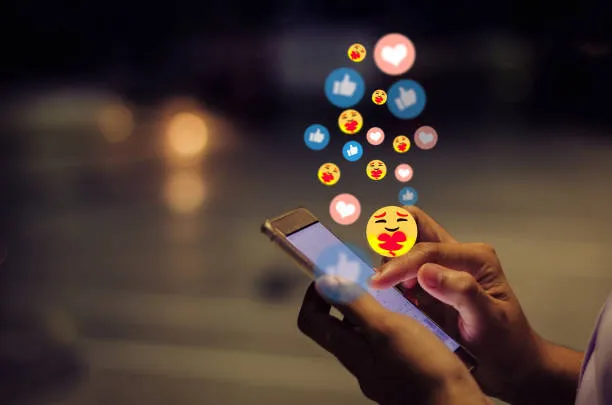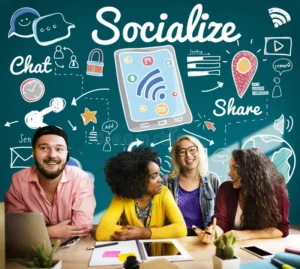Social media has become deeply ingrained in teenage life. Over 95% of teens aged 13 to 17 have access to a smartphone and use online platforms to constantly connect with friends, share updates, and showcase carefully curated versions of their lives.
While social media offers many benefits, its ubiquitous presence also shines a harsh light on issues simmering under the surface of many high schools. If anything, it’s a less-than-ideal positive social media platform.
Beyond the flattering filters and smiling selfies lies a complex array of challenges – from cyberbullying and social isolation to loss of privacy and mental health struggles. The need for likes and followers fuels anxiety and erodes self-esteem. Meanwhile, screen addiction competes with sleep, exercise, and real-world relationships.
In our hyperconnected world, the influence of social media cannot be underestimated or ignored. We all have a shared responsibility to cultivate positive online spaces and help the next generation navigate this technology in a balanced, informed way.
Only through open communication, guidance, and collective vigilance can we truly empower teens and others to use the remarkable tools of the digital age rather than be ruled by them.
The time for action is now – let the conversation begin about how we can take steps toward creating a positive social platform that empowers and uplifts its users.
The Dark Corner of High School Social Media
To not be connected on social media is to almost live as an outcast in high school. With smartphones in pockets and classes using tablets instead of textbooks, it’s virtually impossible to escape the digital realm.
And sure, social media has played a critical role in helping advance communication and access to information. But there is a dark corner, a side of social media that can be harmful and destructive, especially for young minds still developing. When we allow this less than positive social media platform to lead our interactions, it creates an environment that is not conducive to growth and empowerment.
Comparison – The Thief of Joy
Perhaps the most significant issue from social media use in high school is the constant comparison. Teens are bombarded with carefully curated posts and images of their peers’ seemingly perfect lives, leading to feelings of inadequacy and even depression.
It’s easy to forget that what we see on social media is often a highlight reel, not an accurate representation of someone’s life. But for teenagers still trying to figure out who they are and where they fit in, it can be challenging to separate reality from the filtered online versions.
Rates of depression and suicide due to social media have recently prompted the US Surgeon General to issue a public health advisory on the matter. The pressure to fit in and constantly present a perfect image can take a serious toll on mental health, especially for young individuals who are still developing their sense of self and identity. What’s needed is a positive social media platform that can help turn back the tide and promote self-love and acceptance.
Cyberbullying – When the Screen Becomes a Weapon
Another alarming aspect of social media use in high school is cyberbullying. With the ability to hide behind screens, bullies can easily target their victims without facing any consequences or repercussions.
Cyberbullying includes sending hurtful messages, spreading rumors and gossip, or posting embarrassing photos or videos without permission. It has become a significant issue in recent years, with devastating consequences for those who are targeted.
Not only can cyberbullying lead to emotional distress and self-esteem issues, but it can also have severe psychological effects such as anxiety, depression, and even suicidal thoughts. And unfortunately, it’s not just strangers online who engage in this behavior – often, it’s peers from within the same school or community.
“Doing It For The ‘Gram” – Risks, Pranks, and Stunts
In addition to cyberbullying, the rise of social media has also led to a dangerous trend of risky behavior for the sake of getting attention or likes. While children may feel that they are building community on a positive social media platform, putting themselves in danger is far more common.
This phenomenon is commonly referred to as “doing it for the ‘gram” – where individuals will engage in extreme stunts, pranks, or challenges just to gain popularity on social media platforms like Instagram, Snapchat, YouTube, Twitch, and more.
While this may seem harmless at first glance, these actions can have serious consequences. In some cases, individuals have been seriously injured or even killed while attempting dangerous stunts for social media fame. And what’s worse, these trends often encourage others to follow suit and put themselves at risk as well.
For instance, 21-year-old YouTube prankster Tanner Cook was recently shot by one of his prank targets at a Virginia shopping mall food court. Cook runs a channel called “Classified Goon,” he accosts strangers with pranks to for his online followers. The ensuing trial found Cook confused as to why the stranger reacted so violently to his pranks.
Data Privacy & Online Abuse
Rising rates of individuals reporting their personal information being stolen – including images and videos of themselves – highlight the potential dangers of sharing too much online. With social media platforms often changing their privacy policies, it’s important for individuals to be vigilant about what information they share and who can access it.
Even with the best intentions, misunderstandings can lead students to reveal personal information they may not realize is sensitive.
For example, posting a photo of your driver’s license or credit card on social media could unknowingly expose critical personal details to potential hackers who wish to steal your identity or financial information.
In addition to privacy concerns, there is also the issue of online abuse. “Revenge porn” – where an ex-partner shares intimate photos or videos without consent – has become a major issue in the digital age. This not only violates a person’s privacy but can also have severe consequences on their mental health and well-being. As you can see, our current reality paints a bleak picture when it comes to these so-called “positive social media platform” spaces.
Shining A Light In Dark Corners
Reading these stats and stories is enough to make any parent or guardian want to lock up their child’s phone and throw away the key. Yet, our world is ever-advancing in technology, and it is becoming increasingly difficult to avoid the digital world.
So what can we do? How can we help shine a light in the dark corners of our online world? The answer starts with each of us doing our part to promote a better, more positive social media platform.
It All Begins With Knowledge
One of the first steps is education – for both students and adults. Schools should integrate digital literacy and online safety skills into their curriculum to equip students with the awareness and critical thinking needed to navigate social media responsibly.
Lessons on media manipulation, evaluating online sources, protecting personal information, and reporting harmful content should become as essential as math or science in equipping youth for life in the digital age.
Similarly, parents and teachers need to educate themselves on the latest platforms and trends to better monitor and mentor kids. While avoidance was once an option, opting out is no longer realistic or helpful. We must meet teens where they are, online, with guidance and support.
Authentic Communications Matters
Perhaps the reason that many students find themselves addicted to their social media feeds is the lack of authenticity in their interactions. Often, teens feel pressure to present a curated version of themselves online, leading to feelings of inadequacy and comparison.
But what if we taught students the value of genuine communication? Encouraging them to be their true selves and have authentic conversations could lead to more meaningful connections and reduce the negative effects of social media.
By teaching young people how to communicate effectively and authentically online, we can help them build strong relationships and create a positive digital footprint for themselves. And that growth reciprocates in their offline lives as well. That’s where a positive social media platform can help to rewire how teens perceive and use social media.
Empowerment Through Positive Content
Social media is often criticized for its negative effects on mental health due to cyberbullying and unrealistic standards set by influencers. However, it’s important to remember that social media also has the power to spread positivity and empower individuals.
For instance, what would a conversation look like if we focused on sharing uplifting and inspiring content instead of comparing our lives to others? We can create a more supportive and encouraging online community by consciously engaging with positive and meaningful posts.
Let’s not forget that social media also has incredible reach and can be used to promote important causes and raise awareness about various issues. When students feel they have a place to speak up and be heard, it can help break down barriers and promote a sense of belonging.
Cultivating Connection and Community
Schools and communities can also foster positive usage by creating opportunities for meaningful offline connections between students and across generations.
Service projects, mentorships, recreational sports, and creative hobbies can counterbalance social media’s dominance and remind teens that richer relationships and experiences await beyond the screen.
Platforms themselves also have a duty to connect users with mental health resources and tools to encourage healthy usage habits. Functions like screen time trackers, focused feeds that limit unhealthy comparisons, and messaging with counselors could provide guardrails without limiting access.
Most importantly, an open and non-judgmental dialogue must happen across all levels. Teens need safe spaces to voice insecurities and get help without shame or punishment. We can only bring these crucial issues out of the darkness through honesty, vulnerability, and working together.
While social media’s pitfalls are real and dangerous, so too is its potential for community, empowerment, and good. We can mitigate the risks with compassion and collective responsibility and guide our youth to harness technology for creativity, connection, and positive change rather than clout.
Join AlignUs in Shining A Light
We can build a stronger, more inclusive community when we work together to create opportunities for open communication and understanding.
This is especially important for our youth, who are still developing their sense of self and navigating the complexities of relationships. By creating safe spaces online where they can freely express themselves without fear of judgment or repercussions, we can help foster a culture of empathy and support.
At AlignUs, we believe in empowering all individuals to become leaders in their digital communities. That’s why we’ve created one of the first positive social media platform options that bring together resources, like-minded individuals, and opportunities for growth.
Through our user-friendly interface, you can easily connect with others who share your interests, passions, and values. Our goal is to provide a platform where users can create meaningful connections that go beyond just scrolling through feeds or liking posts.
The AlignUs mobile application is growing into a space for online positivity – allowing each of us to bring our voice to the digital table and influence others in a positive way. Our positive social media platform is about sharing content and creating a community where we lift each other up and encourage personal growth.
We believe that empathy and support are key components of building a strong and healthy digital community. By fostering these values within our platform, we hope to create a safe space for individuals to express themselves, connect with others, and make a positive impact online.
Join Us For A Healthier Online Experience
With AlignUs, you have the power to shape your digital experience and be part of a larger movement towards creating an inclusive and compassionate online world. Join us today, and let’s work together to spread kindness, understanding, and support in a positive social media platform.
Learn More About The AlignUs Mobile Application and Positive Social Media Platform




